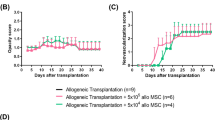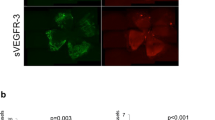Abstract
Purpose
To analyze the immune modulatory effect of low-dose systemic treatment with rapamycin (Rapa) alone or in combination with cyclosporin A (CsA) in a high-responder corneal allograft model.
Methods
A total of 80 C57BL/6 mice received corneal grafts from BALB/c donors. Recipients were treated with either CsA 3 mg/kg/day or Rapa 0.5 mg/kg/day monotherapy or received combined treatment. Immunomodulatory treatment was started on the day of surgery, and continued for 14 days. The frequency of CD4+CD25+Foxp3+ T regulatory cells (Treg) in secondary lymphoid organs was measured by flow cytometry. Development of IFN-γ producing alloreactive T cells was estimated by Elispot. In addition, corneal samples were subjected to real-time RT-PCR analysis for cytokine transcription.
Results
Monotherapy with Rapa significantly delayed allograft rejection (13.4 ± 1.34 days, p = 0.03). However, the combination of both, low-dose Rapa and CsA prolonged corneal allograft survival at a significantly higher level (MST = 17.1 ± 1.37 days, p = 0.0001) than in the control group (MST = 11.2 ± 1.91 days). Rapa monotherapy increased the frequency of CD4+CD25+Foxp3+Treg in draining lymph nodes, whereas addition of CsA reduced Tregs. Monotherapy with Rapa as well as combined treatment prevented development of IFN-γ producing alloreactive T cells in spleen. Combined treatment resulted in down-regulation of intragraft CD3, IL-2, IFN-γ and IL-10 transcription (p = 0.028, p = 0.027, p = 0.028 and p = 0.027 respectively).
Conclusions
Combined treatment with low-dose CsA and Rapa resulted in superior graft survival, and effectively modulated mRNA expression of inflammation and infiltration markers.





Similar content being viewed by others
References
McDonald S, Russ G, Campbell S, Chadban S (2007) Kidney transplant rejection in Australia and New Zealand: Relationships between rejection and graft outcome. Am J Transplant 7:1201–1208
Opelz G (1994) Effect of the maintenance immunosuppressive drug regiment on kidney transplant outcome. Transplantation 58:443–446
Williams KA, Esterman AJ, Bartlett C, Holland H, Hornsby NB, Coster DJ (2006) How effective is penetrating corneal transplantation? Factors influencing long-term outcome in multivariate analysis. Transplantation 81:896–901
Birnbaum F, Böhringer D, Sokolovska Y, Sundmacher R, Reinhard T (2005) Immunosuppression with cyclosporine A and mycophenolate mofetil after penetrating high-risk keratoplasty: a retrospective study. Transplantation 79:964–968
Hill JC (1994) Systemic cyclosporine in high-risk keratoplasty. Short- versus long-term therapy. Ophthalmology 101:128–133
Bailly N, Dunewa I, Schlattmann P, Rieck PW (2008) Significance of cyclosporin A absorption for effective immunomodulatory therapy after high-risk keratoplasty. Ophthalmologe 105:457–462
Poon AC, Forbes JE, Dart JK, Subramaniam S, Bunce C, Madison P, Ficker LA, Tuft SJ, Gartry DS, Buckley RJ (2001) Systemic cyclosporin A in high-risk penetrating keratoplasties: a case-control study. Br J Ophthalmol 85:1464–1469
Inoue KC, Amano S, Sato T, Fujita N, Kagaya F, Kaji Y, Tsuru T, Araie M (2001) Long-term outcome of systemic cyclosporine treatment following penetrating keratoplasty. Jpn J Ophthalmol 45:378–382
Rumelt S, Bersudsky V, Blum-Hareuveni T, Rehany U (2002) Systemic cyclosporin A in high failure risk, repeated corneal transplantation. Br J Ophthalmol 86:988–992
Stepkowski SM, Tian L, Napoli KL, Ghobrial R, Wang ME, Chou TC, Kahan BD (1997) Synergistic mechanisms by which sirolimus and cyclosporin inhibit rat heart and kidney allograft rejection. Clin Exp Immunol 108:63–68
Chen H, Wu J, Luo H, Daloze P (1992) Synergistic effect of rapamycin and cyclosporine in pancreaticoduodenal transplantation in the rat. Transplant Proc 3:892–893
Thompson P, Xu D, Brunette I, Chen H (1998) Combined effect of rapamycin and cyclosporine in prevention of rat corneal allograft rejection. Transplant Proc 30:1033–1035
Birnbaum F, Reis A, Böhringer D, Sokolowska Y, Mayer K, Voiculescu A, Oellerich M, Sundmacher R, Reinhard T (2006) An open prospective pilot study on the use of rapamycin after penetrating high-risk keratoplasty. Transplantation 81:767–772
Sehgal SN (2003) Sirolimus: its discovery, biological properties and mechanism of action. Transplant Proc 35:7–14
Abraham RT, Wiederrecht GJ (1996) Immunopharmacology of rapamycin. Annu Rev Immunol 14:483–510
Furtado GC, Curotto de Lafaille AM, Kutchukhidze N, Lafaille JJ (2002) Interleukin 2 signalling is required for CD4(+) regulatory T cell function. J Exp Med 196:851–857
Battaglia M, Stabilini A, Roncarolo MG (2005) Rapamycin selectively expands CD4+CD25+FoxP3+ regulatory T cells. Blood 105:4743–4748
Coenen JJ, Koenen HJ, van Rijssen E, Kasran A, Boon L, Hilbrands LB, Joosten I (2007) Rapamycin, not cyclosporine, permits thymic generation and peripheral preservation of CD4+ CD25+ FoxP3+ T cells. Bone Marrow Transplant 39:537–545
Tian L, Lu L, Yuan Z, Lamb JR, Tam PK (2004) Acceleration of apoptosis in CD4+CD8+ thymocytes by rapamycin accompanied by increased CD4+CD25+ T cells in the periphery. Transplantation 77:183–189
Zhang EP, Schründer S, Hoffmann F (1996) Orthotopic corneal transplantation in the mouse-a new surgical technique with minimal endothelial cell loss. Graefes Arch Clin Exp Ophthalmol 234:714–719
Niederkorn JY, Stevens C, Mellon J, Mayhew E (2006) CD4+ T-cell–independent rejection of corneal allografts. Transplantation 81:1171–1178
Coster DJ, Williams KA (2005) The impact of corneal allograft rejection on the long-term outcome of corneal transplantation. Am J Ophthalmol 140:1112–1122
Price FW, Whitson WE, Marks RG (1991) Graft survival in four common groups of patients undergoing penetrating keratoplasty. Ophthalmology 98:322–328
Williams KA, Roder D, Esterman A, Muehlberg SM, Coster DJ (1992) Factors predictive of corneal graft survival. Ophthalmology 99:403–414
Scherer MN, Banas B, Mantouvalou K, Schnitzbauer A, Obed A, Krämer BK, Schlitt HJ (2007) Current concepts and perspectives of immunosuppression in organ transplantation. Langenbecks Arch Surg 392:511–523
Zhang EP, Schulte F, Bulfone-Paus S, Hoffmann F (2000) The effect of corticosteroid and cyclosporin A on murine corneal allograft rejection. Graefes Arch Clin Exp Ophthalmol 238:525–530
Reis A, Megahed M, Reinhard T, Braunstein C, Godehardt E, Sundmacher R (2001) RAD, a new immunosuppressive macrolide in murine corneal transplantation. Graefes Arch Clin Exp Ophthalmol 239:689–692
Claerhout I, Beele H, Verstraete A, Van den Broecke C, Kestelyn P (2001) The effect of duration and timing of systemic cyclosporine therapy on corneal allograft survival in a rat model. Graefes Arch Clin Exp Ophthalmol 239:152–157
Brook NR, Waller JR, Bicknell GR, Nicholson ML (2005) Cyclosporine and rapamycin act in a synergistic and dose-dependent manner in a model of immunosuppressant-induced kidney damage. Transplant Proc 37:837–838
Beauregard C, Stevens C, Mayhew E, Niederkorn JY (2005) Cutting edge: Atopy promotes Th2 responses to alloantigens and increases the incidence and tempo of corneal allograft rejection. J Immunol 174:6577–6581
Niederkorn JY (2007) Immune mechanisms of corneal allograft rejection. Curr Eye Res 32:1005–1016
Hargrave S, Chu Y, Mendelblatt D, Mayhew E, Niederkorn J (2003) Preliminary findings in corneal allograft rejection in patients with keratoconus. Am J Ophthalmol 135:452–460
Hargrave SL, Hay C, Mellon J, Mayhew E, Niederkorn JY (2004) Fate of MHC-matched corneal allografts in Th1-deficient hosts. Invest Ophthalmol Vis Sci 45:1188–1193
Chong EM, Dana MR (2008) Graft failure IV. Immunologic mechanisms of corneal transplant rejection. Int Ophthalmol 28:209–222
Niederkorn JY, Stevens C, Mellon J, Mayhew E (2006) Differential roles of CD8+ and CD8- T lymphocytes in corneal allograft rejection in ‘high-risk’ hosts. Am J Transplant 6:705–713
Sonoda Y, Sano Y, Ksander B, Streilein JW (1995) Characterization of cell-mediated immune responses elicited by orthotopic corneal allografts in mice. Invest Ophthalmol Vis Sci 36:427–434
Gong N, Pleyer U, Yang J, Vogt K, Hill M, Anegon I, Volk HD, Ritter T (2006) Influence of local and systemic CTLA4Ig gene transfer on corneal allograft survival. J Gene Med 8:459–467
Pleyer U, Bertelmann E, Rieck P, Hartmann C, Volk HD, Ritter T (2000) Survival of corneal allografts following adenovirus-mediated gene transfer of interleukin-4. Graefes Arch Clin Exp Ophthalmol 238:531–536
Qu Y, Zhang B, Zhao L, Liu G, Ma H, Rao E, Zeng C, Zhao Y (2007) The effect of immunosuppressive drug rapamycin on regulatory CD4+CD25+Foxp3+T cells in mice. Transpl Immunol 17:153–161
Wang H, Zhao L, Sun Z, Sun L, Zhang B, Zhao Y (2006) A potential side effect of cyclosporin A: inhibition of CD4(+)CD25(+) regulatory T cells in mice. Transplantation 82:1484–1492
Kawai M, Kitake H, Mathieu C, Waer M, Pirenne J (2005) Inhibitory and stimulatory effects of cyclosporin A on the development of regulatory T cells in vivo. Transplantation 79:1073–1077
Wang S, Jiang J, Guan Q, Lan Z, Wang H, Nguan CY, Jevnikar AM, Du C (2008) Reduction of Foxp3-expressing regulatory T cell infiltrates during the progression of renal allograft rejection in a mouse model. Transpl Immunol 19:93–102
Haanstra KG, Wubben JA, Korevaar SS, Kondova I, Baan CC, Jonker M (2007) Expression patterns of regulatory T-cell markers in accepted and rejected nonhuman primate kidney allografts. Am J Transplant 7:2236–2246
Graca L, Cobbold SP, Waldmann H (2002) Identification of regulatory T cells in tolerated allografts. J Exp Med 195:1641–1646
Chauhan SK, Saban DR, Lee HK, Dana R (2009) Levels of Foxp3 in regulatory T cells reflect their functional status in transplantation. J Immunol 182:148–153
Bunnag S, Allanach K, Jhangri GS, Sis B, Einecke G, Mengel M, Mueller TF, Halloran PF (2008) FOXP3 expression in human kidney transplant biopsies is associated with rejection and time post transplant but not with favorable outcomes. Am J Transplant 8:1423–1433
Hara M, Kingsley CI, Niimi M, Read S, Turvey SE, Bushell AR, Morris PJ, Powrie F, Wood KJ (2001) IL-10 is required for regulatory T cells to mediate tolerance to alloantigens in vivo. J Immunol 166:3789–3796
Ochando JC, Yopp AC, Yang Y, Garin A, Li Y, Boros P, Llodra J, Ding Y, Lira SA, Krieger NR, Bromberg JS (2005) Lymph node occupancy is required for the peripheral development of alloantigen-specific Foxp3+ regulatory T cells. J Immunol 174:6993–7005
Schneider MA, Meingassner JG, Lipp M, Moore HD, Rot A (2007) CCR7 is required for the in vivo function of CD4+ CD25+ regulatory T cells. J Exp Med 204:735–745
Niederkorn JY, Mellon J (1996) Anterior chamber-associated immune deviation promotes corneal allograft survival. Invest Ophthalmol Vis Sci 37(13):2700–2707
Niederkorn JY (1999) The immune privilege of corneal allografts. Transplantation 67:1503–1508
Streilein JW (1996) Ocular immune privilege and the Faustian dilemma. The Proctor lecture. Invest Ophthalmol Vis Sci 37:1940–1950
Streilein JW, Niederkorn JY (1981) Induction of anterior chamber-associated immune deviation requires an intact, functional spleen. J Exp Med 153:1058–1067
Plsková J, Duncan L, Holán V, Filipec M, Kraal G, Forrester JV (2002) The immune response to corneal allograft requires a site-specific draining lymph node. Transplantation 73:210–215
Yamagami S, Dana MR (2001) The critical role of lymph nodes in corneal alloimmunization and graft rejection. Invest Ophthalmol Vis Sci 42:1293–1298
Zheng XX, Sanchez-Fueyo A, Domenig C, Strom TB (2003) The balance of deletion and regulation in allograft tolerance. Immunol Rev 196:75–84
Sánchez-Fueyo A, Weber M, Domenig C, Strom TB, Zheng XX (2002) Tracking the immunoregulatory mechanisms active during allograft tolerance. J Immunol 168:2274–2281
Author information
Authors and Affiliations
Corresponding author
Additional information
This work was supported by Deutsche Forschungsgemeinschaft (Pl 150/14-2) and Sonderforschungsbereich (SFB650 TP14).
Birgit Sawitzki and Uwe Pleyer made an equal contribution
Rights and permissions
About this article
Cite this article
Stanojlovic, S., Schlickeiser, S., Appelt, C. et al. Influence of combined treatment of low dose rapamycin and cyclosporin A on corneal allograft survival. Graefes Arch Clin Exp Ophthalmol 248, 1447–1456 (2010). https://doi.org/10.1007/s00417-010-1420-z
Received:
Revised:
Accepted:
Published:
Issue Date:
DOI: https://doi.org/10.1007/s00417-010-1420-z




